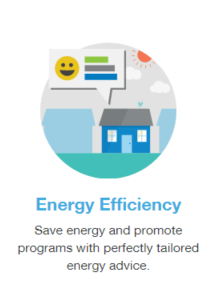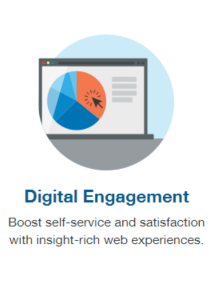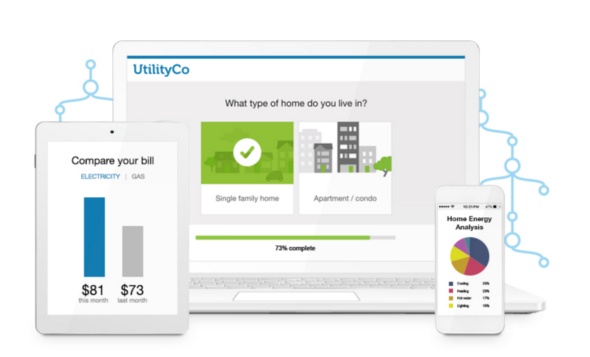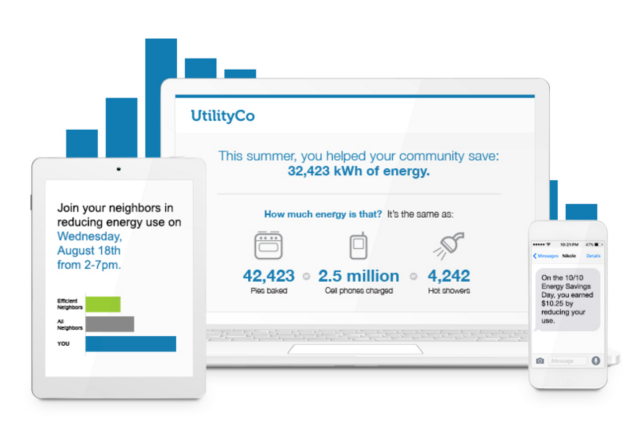Opower is a specialist technology provider for utilities promising to usher in a new era of electricity retailer-customer relationships. Their ‘customer engagement platform’ allows retail electricity customers to have an unprecedented level of transparency into their own electricity consumption patterns, and can also deliver tailored advice about actions they can take to minimise costs – before they get whacked with a massive bill.
Some useful analogies to what Opower offers is mobile banking or mobile phone data usage apps: In the modern interconnected world, most of us would prefer not to wait for their monthly (or quarterly) account statement to see where their balance is at. Mobile connectivity allows you to check the current status of your account at any time – knowing instantly where you stand and changing your behaviour accordingly. Imagine if your retailer could also communicate to you (through an app or via SMS, for example) when you’re using more electricity than usual – much as your phone service provider probably does (or should do!) when you’ve chewed through a substantial portion of your allotted data or minutes. These are some of the features that Opower’s platform aims to deliver to electricity consumers through their retailers.
Although customer’s can’t ask for Opower’s platform yet, it is being considered for adoption by a number of Australian electricity retailers – who are sure to trumpet the benefits once it does become available. In the meantime, we’ve had a chat with Opower to learn more about what they offer in order to get a glimpse of the future.
 Q: In a nutshell, what does Opower’s technology platform do for electricity retailers and their residential customers? How does it change the relationship between households and their retailers compared to the conventional model?
Q: In a nutshell, what does Opower’s technology platform do for electricity retailers and their residential customers? How does it change the relationship between households and their retailers compared to the conventional model?
Opower is an enterprise software company that uses Big Data analytics and behavioural science to transform the way energy retailers relate to their customers and to achieve a clean energy future.
In a conventional model, customers don’t spend very much time thinking about their energy use except for when they are checking their monthly bill – just a few minutes a year – and they have no relationship with their energy providers.
 So energy retailers use Opower’s platform to engage their customers – at the key moments that customers care about, such as when a high bill is likely, or when a customer moves house. Opower’s platform enables the retailer to deliver proactive and seamless omni-channel communications, such as self-service web, email and SMS.
So energy retailers use Opower’s platform to engage their customers – at the key moments that customers care about, such as when a high bill is likely, or when a customer moves house. Opower’s platform enables the retailer to deliver proactive and seamless omni-channel communications, such as self-service web, email and SMS.
This kind of effortless and productive communication help raise customer satisfaction, manage energy demand, and lower service costs. In the model powered by Opower’s dataset of over 500 million meter reads – the biggest on earth – energy retailers are elevating the customer experience by empowering energy users with insights about their specific energy habits and customized tips to take control of their energy use.
Q: Do households in Australia have the option right now to switch over to Opower’s platform? Who is it available to?
Opower is in conversation with a number of Australian utilities about partnering with them to deploy the service here. Typically the utilities that we work with offer their full customer base access to the Opower platform. Our flexible platform enables our retailer partners to customize the platform based on their own brand and customer needs so in theory, once a utility partners with Opower, all of its customers could access the service.
Q: Right now, households receive either quarterly or monthly electricity bills. In many cases, their bill total is usually unknown to them until the bill actually arrives. If they’re on track for an unusually high bill for the period they have no way of knowing. What does Opower’s platform do to help end customers keep one step ahead of the game in order to prevent ‘bill shock’?
We want consumers to feel informed and empowered. Opower’s tools help consumers gain insights and trends about their energy use over time, during specific weather conditions, in comparison to others of a similar energy profile, and many other advanced analysis. Not only can they access this information, but Opower’s tools also provide personalized, actionable strategies that they can implement in order to take control over their bills.
Where smart meters have been deployed, we can provide even more detailed insights to consumers. In the USA, we’ve deployed multiple demand side management programmes to reduce peak demand, using specific email, SMS and IVR communications. High bills specifically, are highly correlated with extreme weather and we have worked with energy providers around the world with seasonal reports to help them understand their upcoming irregular bills and remind them on how their usage was also higher in other extreme seasons.
Q: How does Opower data show that its platform increases customer engagement?
Energy retailers who are gaining the trust of their customers through Opower’s customer engagement tools are unlocking strategic business value — from higher loyalty and satisfaction, to lower costs, to new revenue, to comprehensive demand management.
With our customer engagement platform, we capture all customer data, our algorithms produce energy-specific insights, we build communications for omni-channel delivery and we enable our utility partners to gain full feedback on their efforts, for continuous improvement. This approach enables the utility to truly capture a customer’s attention when they care the most. This is illustrated with our high digital engagement rates (such as open rates, click-throughs, online energy audits completed, new online accounts created). And this helps our utility partners activate their customers and motivate them to take actions aligned with their objectives (such as greater adoption of self-service tools and lower call volumes into the call center).
Q: With the high penetration of residential rooftop solar in Australia, more and more households are interested in developing ways to use their solar energy in the most effective ways possible – which for most homes means self-consuming it instead of ‘wasting’ it by sending it into the grid for virtually nothing. Becoming proactive requires first understanding what their usage patterns are and how they can change them. However, generally speaking they don’t yet have the data/information available – either from their own solar systems, household appliances or from their electricity retailers – to enable them to do this. Can Opower connect the dots for them, and how?
Empowering customers with insights on energy use and specifically tailored strategies to take control of their energy use is exactly Opower’s commitment. Opower is working with our retailer partners around two primary use cases for solar: 1.) Identifying customers with high propensity to purchase solar and 2.) providing customers with insights and visibility into solar production and impact on feed-in-tariffs.
For the first, Opower helps retailers identify customers that are most likely to purchase solar based on home profiles (example: home owners with discretionary income that have participated in other retailer programs in the past) and usage profiles to understand which customers will benefit the most from installing rooftop solar. We are able to help our partners do this by applying advanced clustering techniques, such as vector quantization, to identify a series of recurring patterns across the usage data. Specifically, based on our statistical clustering, we identify distinct hourly electric load patterns and group them into archetypes. This enables retailers to target just the load archetype that consumes the most when PV panels produce the most.Next, we are helping our partners with high residential solar penetration provide their customers with insight into their solar production. For instance, we partnered with Pacific Gas & Electric of California, USA, to give their customers participating in a feed-in-tariff program (known as “Net Energy Metering (NEM)”) insights into their solar production and the subsequent impact on their bills, by providing a new online self-service tool built on our NextWeb web infrastructure.
© 2016 Solar Choice Pty Ltd
- Running Cost of Air Conditioners – Explained - 7 October, 2025
- Air Conditioner Rebate South Australia: What You Need to Know - 19 September, 2025
- Air Conditioner Rebates in Queensland: What You Need to Know - 19 September, 2025